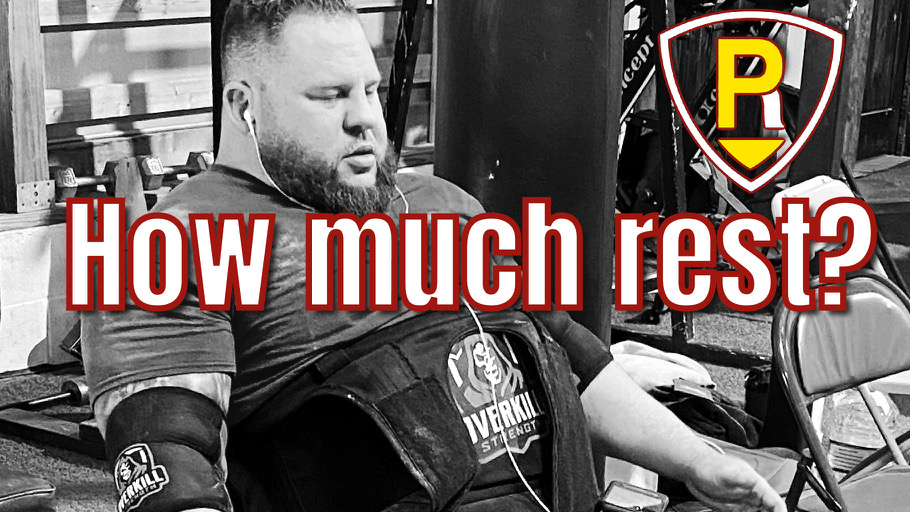
25 Jul Rest Periods: how much time between sets?
Rest periods: How much time between sets
Rest and strength training. This question comes up a lot in strength training, and I’ve noticed it since I released my book 10/20/Life. I have a few different opinions on this that I’ll share because there isn’t a single answer. It all depends on where you are in your training, your exact goals, and how in shape you are at that specific time. In other words, there is NO exact blanket statement that you have to live by. Just as each person is unique and requires a different stimulus to reach their goals, so is the same with rest periods.
As a general rule of thumb, I suggest you allow adequate recovery on your main lifts and move faster during your assistance work. On the other hand, I don’t ever want you to miss big lifts due to being too out of breath from the set before and not recovered. I understand that this is still a somewhat vague answer, but listen to what I have to say.
Rest experimentation: Where are you in training? (offseason or precontest)
Where you are in training, i.e., offseason or near a competition or peaking phase, should be the first thing you consider. Why? Because if you’re close to a meet or test day, I won’t change too much up. If your actions work for you, then don’t change them. Playing around and experiencing can be the undoing of some lifters, especially if they are already successful. But, if it’s time to experiment and what you are doing may not be ideal, then use the offseason to experiment with the pace of your lifting and how much time between your lifts.
Recovery time and main lift importance
Your main lift is where you must make every single rep as perfect as possible. These are the most dangerous (in regards to injury) and powerful (in regards to stimulus) compound movements – this is the meat and potato of your program, if you will. You CANNOT start to create bad habits (engrams) due to fatigue which will come back to haunt you when it’s time to push some weight. Again, this can apply to the offseason or precontest.
With your assistance (think the more minor things, i.e., DB work, rows, sled drags, core work), I have no problem and like the idea of moving fast through these to build endurance, get your heart rate up and challenge yourself differently at times. However, with your skill movements Squat, bench, Dead, OHP, etc., I never suggest moving too fast unless the loads are SUPER light and your form or technique is something that resembles a finely tuned machine. Otherwise, you are no different than the cross-fitters you make fun of who do compound lifts for time.
Competing in powerlifting
If the endgame is to compete in powerlifting, strongman, or the like, see how much time you get at an average meet between lifts and go from there. A lot of the time, it depends on the pace of the meet, how many lifters are signed up, and how many flights total (a flight is the group of people in or around your class). If you’re on a long flight (15 or more), you’ll have 20 minutes between lifts. If in a shorter flight (10 lifters or less), be ready to lift every 10min or so. A lot of the time, for the shorter flights, the meet director will slow the pace down and take a break to slow things down. Do your research and try your best to determine how big of a meet you are doing to get a ballpark of how fast the meet will move.
Resting Reference points
Here are a few things that might be a reference point for your strength-training program as far as rest is concerned and what I’ve advocated for clients and friends over the years.
Main type lift (applies to compound assistance work too): 2-10min. Example: Squat/Bench/Dead/Barbell-row/Block/Rack-pull/Board press/Heavy GM etc. Again, the closer you draw toward a meet, the volume comes down, the intensity goes UP, and longer rest periods are needed. You’ll look at the opposite for off-season work: higher volume, lower intensity, and fewer rest periods.
Assistance lifts 1-4min. Example: Chin/shrug/Sled drag/McGill big 3/Hammer curl/Band fly/press-down/DB work etc.
Very little rest: Your light day of training
Your 4th training day – The fluff and buff, which I advocate in 10/20/Life, is a lighter BB-type day that I suggest you move quickly and get a nice pump. Experiment with this as your 4th training day. This can build endurance, attack weak points, or even a recovery workout that helps you move some blood around. Again, the pace is fast, and the entire workout shouldn’t take longer than 20min-30min or so. I also highly suggest that you do some form of cardio for general health, i.e., walking 4-5x per week, pulling the sled after every session, and attacking your core with the McGill big three every day.
You can book a Virtual consult with Brian here for those who would like help with coaching, programming, or coming back from a back injury. You can also read some of his client success testimonials HERE.
Brian Carroll
Latest posts by Brian Carroll (see all)
- Brian Carroll Coaches the Birddog - April 24, 2024
- Protected: -Header Image Post Template 2024 - April 18, 2024
- Brian Carroll X Professor Stu McGill full interview 2024 - April 16, 2024





Sorry, the comment form is closed at this time.